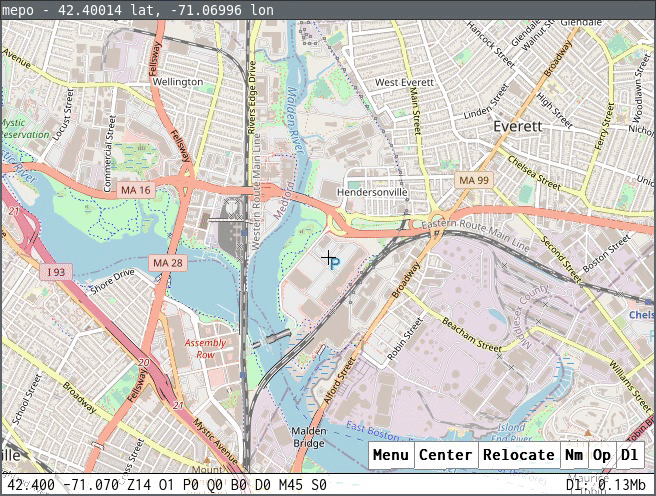Mepo is a fast, simple, hackable OSM map viewer for mobile and desktop Linux! Free your navigation now.

Mepo is a fast, simple, and hackable OSM map viewer for desktop & mobile Linux devices (like the PinePhone, Librem 5, postmarketOS devices etc.) and both environment's various user interfaces (Wayland & X inclusive). Environments supported include Phosh, Sxmo, Plasma Mobile, desktop X, and desktop Wayland. Mepo works both offline and online, features a minimalist both touch/mouse and keyboard compatible interface, and offers a UNIX-philosophy inspired underlying design, exposing a powerful command language called Mepolang capable of being scripted to provide things like custom bounding-box search scripts, bookmarks, and more.
Get started now:
Features
- Fast & usable in resource-constrained environments:
- Mepo launches quickly and runs quickly on the PinePhone and other resource-constrained devices.
- Mepo renders using SDL which keeps things fast and lightweight; also as a bonus: portable.
- Built in a non GC'd language (Zig) with an aim toward careful memory usage and allocations/deallocations
- UNIX-philosophy inspired design - scriptability via mepolang:
- Mepo's UI is built to do one thing well: download & render maps. Extra functionality is enabled via its command language / API (Mepolang).
- Reduces overall application logic complexity, handing over to shell-scripting integral features like map bounding-box searches, location search lookup, bookmarking, dropping pins, routing, rebinding keys, and more.
- Uses single abstraction (central pin API via Mepolang) for indicating and placing user-defined coordinates graphically on the map (e.g. same mechanism used generically between POI searches, bookmarks, routing, etc.)
- Existing OSM tools for search & routing like the Nominatim, Overpass, and GraphHopper APIs are integrated through bundled shell scripts; customize to your heart's content or write your own scripts for custom integrations.
- Bundled scripts utilize menuing and user input functionality via zenity rather then implementing application-specific input logic.
- Offline operation as a first-class feature:
- Downloading of maps for later offline use can be done non-interactively through a command-line flag.
- Users can download based on a bounding-box or a user-specified radius from a specific point for multiple zoom levels.
- Offline usage is a primary usecase and should be treated as such, we can't assume a user is always online.
- Supports touch AND keyboard-oriented operation:
- A map application must of course be usable with a mouse / touch, but the keyboard as a tool for map navigation has been overlooked in in map applications.
- Provides vi-like (& customizable) keybindings out-of-the-box.
- Should be usable in touch-oriented environments like the PinePhone and similar where a physical keyboard isn't present.
- Compatible across multiple Linux mobile environments including: Phosh, Plasma Mobile, Sxmo, and Swmo. Being written in SDL ensures good support and portability to other future environments as well.
